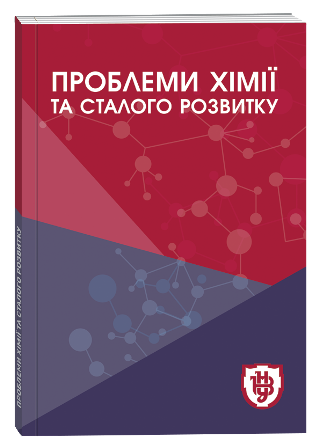ANTIOXIDANT ACTIVITY OF 1-(ARYLSULFUNYLMETHYL)- 2,3-DIHIDRO-PYRROLO[1,2-а]QUINAZOLIN-5(1H)-ONES
DOI:
https://doi.org/10.32782/pcsd-2023-2-3Keywords:
dihydropyrrolo[1,2-a]quinazolin-5(1H)-ones, sulfanylmethyl-functionalized derivatives, antioxidant activity, «structure-activity» relationshipAbstract
The aim of the current study is the evaluation of the antioxidant properties of new sulfur-functionalized pyrroloquinazolinone structures, 1-(arylsulfanylmethyl)-2,3-dihydropyrrolo[1,2-a]quinazolin-5(1H)-ones 3, recently synthesized by the authors via arylsulfenyl chlorides 1 initiated electrophilic cyclization of the corresponding 2-(3-butenyl) quinazolinones 2. The molecular framework of this type of compounds is a result of two privileged scaffolds combination – quinazolinone and pyrrole, both with a powerful pharmacological profile. To evaluate the antioxidant activity of the synthesized 1-(arylsulfanylmethyl)-2,3-dihydropyrrolo[1,2-a]quinazoline- 5(1H)-ones 3a-k (a series of 11 compounds), the 1,1-diphenyl-2-picrylhydrazyl (DPPH) radical inhibition test was used under conditions close to physiological at a concentration of 5 mM with ascorbic acid (AA) as a control. It was found that all tested compounds demonstrated inhibition of DPPH radicals in the range from 43.3 to 84.7%. Based on the screening results, the hit compounds 3c, 3f, 3i and 3j were identified with an inhibition percentage of 56.2, 55.6, 55.8 and 84.7%, respectively. The “structure-activity” relationship revealed a positive effect of the NO2 group at position 7 of pyrrolo[1,2-a] quinazoline scaffold on the antioxidant activity of the studied compounds. In particular, the derivative 3j, containing 4-FC6H4SCH2 and 7-NO2 groups, demonstrated the best ability to inhibit DPPH radicals (84.7%). On the other hand, the replacement of the fluorine atom with an electron-donating methyl group led to a 28% decrease in activity (compound 3c).
References
Seboletswe, P., Awolade, P., Singh, P. Recent developments on the synthesis and biological activities of fused pyrimidinone derivatives. Chem. Med. Chem. 2021. 16 (13). 2050–2067. https://doi.org/10.1002/cmdc.202100083
Abbas, N., Swamy, G.P.M., Dhiwar, P.S., Patel, S., Devasahayam, G. Fused and substituted pyrimidine derivatives as profound anti-cancer agents. Anti-Cancer Agents Med. Chem. 2021. 21 (7). 861–893. https://doi.org/10.2174/1871520620666200721104431
Li, W., Zhang, J.,Wang, M., Dong, R., Zhou, X., Zheng, X., Sun, L. Pyrimidine-fused dinitrogenous pentaheterocycles as a privileged scaffold for anti-cancer drug discovery. Curr. Top. Med. Chem. 2022. 22 (4). 284–304. https://doi.org/10.2174/1568026622666220111143949
Yadav, T.T., Shaikh, G.M., Kumar, M.S., Chintamaneni, M., Yс, M. A review on fused pyrimidine systems as EGFR inhibitors and their structure-activity relationship. Front. Chem. 2022. 10. 861288. https://doi.org/10.3389/fchem.2022.861288
Dai, X.J., Xue, L.P., Ji, S.K., Zhou, Y., Gao, Y., Zheng, Y.C., Liu, H.M., Liu, H.M. Triazole – fused pyrimidines in target ‒ based anticancer drug discovery. Eur. J. Med. Chem. 2023. 249. 115101. https://doi.org/10.1016/j.ejmech.2023.115101
Gatadi, S., Lakshmi, T.V., Nanduri, S. 4(3H)-Quinazolinone derivatives: promising antibacterial drug leads. Eur. J. Med. Chem. 2019. 170. 157–172. https://doi.org/10.1016/j.ejmech.2019.03.018
Ghosh, P.,Ganguly, B., Das,S. C–H functionalization of quinazolinones by transition metal catalysis. Org. Biomol. Chem. 2020. 18 (24). 4497–4518. https://doi.org/10.1039/D0OB00742K
Alsibaee, A.M., Al-Yousef, H.M., Al-Salem, H.S. Quinazolinones, the winning horse in drug discovery. Molecules. 2023. 28 (3). 978. https://doi.org/10.3390/molecules28030978
Pathania, S., Rawal, R.K. Pyrrolopyrimidines: an update on recent advancements in their medicinal attributes. Eur. J. Med. Chem. 2018. 157. 503–526. https://doi.org/10.1016/j.ejmech.201808.023
Adel, M., Serya, R.A.T., Lasheen, D.S., Abouzid, K.A.M. Pyrrolopyrimidine, a multifaceted scaffold in cancer targeted therapy. Drug Res. 2018. 68 (9). 485–498. https://doi.org/10.1055/s-0044-101256
Petri, G.L., Spano, V., Spatola, R., Holl, R., Raimondi, M.V., Barraja, P., Montalbano, A. Bioactive pyrrole – based compounds with target selectivity. Eur. J. Med. Chem. 2020. 208. 112783. https://doi.org/10.1016/j.ejmech.2020.112783
Seipp, K., Geske, L., Opatz, T. Marine Pyrrole Alkaloids. Mar. Drugs. 2021. 19 (9). 514. https://doi.org/10.3390/md19090514
Jeelan Basha, N., Basavarajaiah, S. M., Shyamsunder, K. Therapeutic potential of pyrrole and pyrrolidine analogs: an update. Mol. Divers. 2022. 26 (5). 2915–2937. https://doi.org/10.1007/s11030-022-10387-8
Lambert, B., Semmler, A., Beer, C., Voisey, J. Pyrroles as a potential biomarker for oxidative stress disorders. Int. J. Mol. Sci. 2023. 24 (3). 2712. https://doi.org/10.3390/ijms24032712
Mhaske, S.B., Argade, N.P. The chemistry of recently is lated naturally occurring quinazolinone alkaloids. Tetrahedron. 2006. 62. 9787–9826. https://doi.org/10.1016/j.tet.2006.07.098
Al-Shamma, A., Drake, S., Flynn D.L., Mitscher, L.A., Park Y.H., Rao, G.S., Simpson, A., Swayze, J.K., Veysoglu, T., Wu, S.T. Antimicrobial agents from higher plants. Antimicrobial agents from Peganumharmada seeds. J. Nat. Prod. 1981. 44. 745–747. https://doi.org/10.1021/np50018a025
Michael, J.P. Quinoline, quinazoline and acridonealkaliods. Nat. Prod. Rep. 2008. 25. 166-187.https://doi.org/10.1039/B612168N
Liu, J.F., Ye, P., Sprague, K., Sargent, K., Yohannes, D., Baldino, C.M., Wilson, C.J., Ng, S.C. Novel one-pot total syntheses of deoxyvasicinone, mackinazolinone, isaindigotone, and their derivatives promoted by microwave irradiation. Org. Lett. 2005, 7(15), 3363–3366. https://doi.org/10.1021/ol0513084
Mori, M., Kobayashi, H., Kimura,M., Ban, Y. One-pot synthesis of quinazoline derivatives by use of palladium catalyzed carbonylation. Heterocycles. 1985. 23. 2803–2806. https://doi.org/10.3987/R-1985-11-2803
Krichner, F.K., Zalay, A.W. 3-Amino-2,3-dihydro-4(1H)quinazolinones. USPatent 3843654. 1974.
Honda, T., Enomoto, H., Kawashima, K., Takaoka, S., Fujioka, Y., Matsuda, M., Ohashi, K., Fujita, Y., Hirai, S.I., Kurashima, H. Novel compound having PARP inhibitory activity. WO Patent 2013008872/A1. 2013.
Sutherell, C. L.,Tallant, C.,Monteiro, O.P.,Yapp, C., Fuchs, J.E., Fedorov, O., Siejka, P., Müller, S., Knapp, S., Brenton, J. D., Brennan, P. E., Ley, S.V. Identification and development of 2,3-dihydropyrrolo [1,2-a] quinazolin-5(1H)-one inhibitors targeting bromodomains within the switch/sucrose nonfermenting complex. J. Med. Chem. 2016. 59(10). 5095–5101. https://doi.org/10.1021/acs.jmedchem.5b01997
Vangamudi, B., Paul, T.A., Shah, P.K., Kost-Alimova, M., Nottebaum, L., Shi, X., Zhan, Y., Leo, E., Mahadeshwar, H.S., Protopopov, A., Futreal, A., Tieu, T.N., Peoples, M., Heffernan, T.P., Marszalek, J.R., Toniatti, C., Petrocchi, A., Verhelle, D., Owen, D.R., Andersen, J.N. The SMARCA2/4 ATPase domain surpasses the bromodomainas a drug targen SWI/SNFmutant cancers: insights from cDNA rescue and PFI-3 inhibitor studies. Cancer Research. 2015. 75(18). 3865–3878. https://doi.org/10.1158/0008-5472.can-14-3798
Vaskevych, A.I., Savinchuk, N.O., Vaskevych, R.I., Rusanov, E.B., Vovk, M.V. Chalcogenation/pyrrolo(pyrido) annulations of 2-(3-butenyl)quinazolin-4(3H)-ones by arylsulfenyl(selenyl) chlorides. Tetrahedron. 2022. 111. 132722. https://doi.org/10.1016/j.tet.2022.132722
Vaskevych, A.I., Savinchuk, N.O., Vaskevych, R.I., Rusanov, E.B., Grygorenko, O.O., Vovk, M.V. The PIFAinitiated oxidative cyclization of 2-(3-butenyl)quinazolin-4(3H)-ones – an efficient approach to 1-(hydroxymethyl)-2,3-dihydropyrrolo[1,2-a]quinazolin-5(1H)-ones. Beilst. J. Org. Chem. 2021. 17. 2787–2794. https://doi.org/10.3762/bjoc.17.189
Савінчук, Н, Васькевич, А., Яковинчук, Н., Грозав, А., Васькевич, А., Панчук, О., Салієва, Л., Сливка, Н., Вовк, М. Оцінка протимікробної дії халькогенвмісних піроло[1,2-a]хіназолін-5(1H)-онів. Проблеми хімії та сталого розвитку. 1. 54–63. https://doi.org/10.32782/pcsd-2022-1-8
Cho, J.Y., Bae, S.H., Kim, H.K., Lee, M.L., Choi, Y.S., Jin, B.R., Lee, H. J., Jeong, H.Y., Lee,Y.G., Moon, J.H. New quinolinone alkaloids from chestnut (Castaneacrenata Sieb) honey. J. Agric. Food Chem. 2015. 63(13). 3587–3592. https://doi.org/10.1021/acs.jafc.5b01027
Thirunavukkarasu, P., Ramkumar, L., Ramanathan, T., Silambarasan, G. Antioxidant activity of selected coastal medicinal plants. World J. Fish and Marine Sci. 2010. 2(2). 134–137.
Battin, E.E., Brumaghim, J.L. Antioxidant activity of sulfur and selenium: a review of reactive oxygen species scavenging, glutathione peroxidase, and metal-blinding antioxidant mechanisms. Cell. Biochem. Biophys. 2009. 55. 1-23. https://doi.org/10.1007/s12013-009-9054-7
Valko, M., Rhodes, C.J., Moncol, J., Izakovic, M., Mazur, M. Free radicals, metals and antioxidants in oxidative stress-induced cancer. Сhemico-Biological Inter. 2006. 160(1). 1-40. https://doi.org/10.1016/j.cbi.2005.12.009
Parcel, S. Sulfur in human nutrition and applications in medicine. Altern. Med. Rev. 2002. 7(1). 22–44. https://altmedrev.com/wp-content/uploads/2019/02/v7-1-22.pdf
Atmaca, G. Antioxidant effects of sulfur-containing amino acids. Yonsei Medical Journ. 2004. 45(5). 776–788. https://doi.org/10.3349/ymj.2004.45.5.776
Pappa, A., Franco, R., Schoneveld, O., Galanis, A., Sandaltzopoulos, R., Panayiotidis, M.I. Sulfur-containing compounds in protecting against oxidant-mediated lung diseases. Curr. Med. Chem. 2007. 14(24). 2590–2596. https://doi.org/10.2174/092986707782023262
Mukwevho, E., Ferreira, Z., Ayeleso, A. Potential role of sulfur-containing antioxidant systems in highly oxidative environments. Molecules. 2014. 19(12). 19376–19389. https://doi.org/10.3390/molecules191219376
Gaucher, C., Boudier, A., Bonetti, J., Clarot, I., Leroy, P., Parent, M. Glutathione: antioxidant properties dedicated to nanotechnologies. Antioxidants. 2018. 7(5). 62. https://doi.org/10.3390/antiox7050062
Brand-Williams, W., Cuvelier, M.E., Berset, C. Use of a free radical method to evaluate antioxidan tactivity. LWT – Food Science and Technology. 28(1). 1995. 25–30. https://doi.org/10.1016/S0023-6438(95)80008-5






